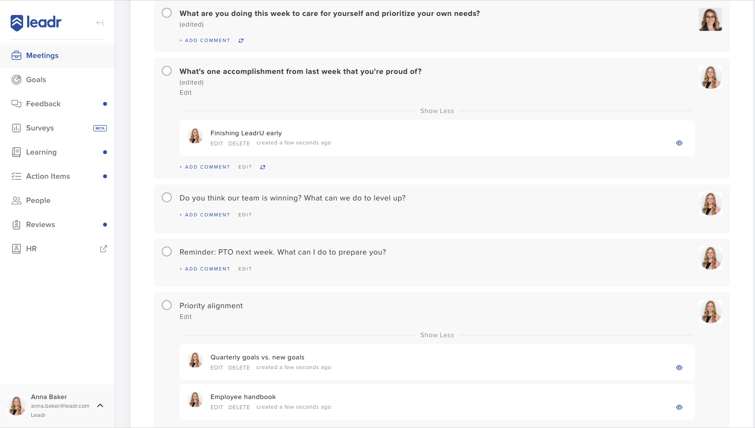1:1 meetings are the most powerful people development tool a leader has, but only if it’s used wisely. In a schedule overrun with meetings, adding one more may feel like the last thing you want to do, but the goal is to make meetings more effective, not create more meetings. Here’s how to ensure your 1:1s are the most productive part of your week.
Remember The Purpose Of A 1:1 Meeting
Have a clear purpose for these meetings: developing your team members. Remember, your most important job as a manager is developing your team members. If your team member leaves the meeting feeling heard or cared for, your time has not been wasted.
Clarifying your purpose for the 1:1 before you meet with your staff is key. Some managers worry their team will feel micromanaged by adding 1:1 meetings to their schedule. This is understandable if the purpose of the meeting is simply to keep tabs on progress, drill into areas of improvement, or pile on more work.
However, if you’re transparent about the goal of the meeting: to help them grow and develop, most of your team won’t turn away from that opportunity. Employees who feel their voice is heard are 4.6 times more likely to feel empowered to perform their best work. Let them know their voice is valued and that 1:1s are their biggest opportunity to speak into the organization’s mission.
Let them know the meeting is an opportunity for two-way conversation on their goals and path forward. Allow them to speak into the meeting agenda by creating a shared space in your meeting tool where they can add talking points and see your priorities before the meeting. Achieving this alignment beforehand will build trust, create clarity, and allow you both to better prepare. Here’s a snippet of how you can collaborate on meeting agendas in Leadr.

1:1 Meeting Agenda
Remember, these meetings should be development-focused, not just project-focused. Here are some questions you might add to the agenda that add value versus simply checking through your priorities list:
- How are you caring for yourself this week?
- Do you feel good about what you accomplished last week?
- How can I help you meet your goals this week?
- Who should we recognize for doing an amazing job on the team?
- What’s one highlight from last week?
- What’s one of our organizational values that you’re focused on this week?
Having a clear agenda when you walk into your 1:1s will help you maximize time to insure you’re hitting on the necessary topics to move the needle and continue developing your staff.

Achieving an Appropriate Meeting Cadence:
How often you have a 1:1 will look different for everyone, but the key is consistency. Showing up to your 1:1s tells your team members you value their time and prioritize their development. At Leadr, many of our teams are remote. When you’re not in an office with your team every day, it’s easy to get distracted by each email or Slack that comes in versus staying focused on your critical goals. We've found that each week, our 1:1s help us realign on what goals matter that week and allow our leaders to help us navigate priorities and purpose for the week. To us, the realignment and empowerment that comes from these meetings is worth 45 minutes in a 40 hour work week.
We believe one-to-one meetings are most effective when you are able to meet with each team member for at least 30 minutes each week. If time is tight, meeting bi-weekly or for 20 minutes, using the 15:5 format, can help to maximize your time.
If you’re unsure where to start, try beginning with a 45-minute 1:1 with each of your team members. Create your agenda ahead of time, come prepared, and see how effective the time was.
Everyone's capacity is different, but if you find yourself with more than 5 or 6 1:1 meetings a week, it may be time to rethink how many direct reports you have. Is there someone else that could lead alongside you? Remember - as a leader, your most important job is empowering your team members. You can't do that well if you're spread too thin.
When it comes to 1:1 meetings, the goal isn’t to check the box. The goal is to care for and develop the team members that are moving the needle at your organization. Looking for more ways to engage and grow your team? Check out our free download, The Five Foundations of A High-Performing Team.

No Comments Yet
Let us know what you think